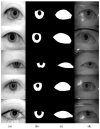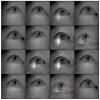Self-Supervised Learning Framework toward State-of-the-Art Iris Image Segmentation
- PMID: 35336305
- PMCID: PMC8951447
- DOI: 10.3390/s22062133
Self-Supervised Learning Framework toward State-of-the-Art Iris Image Segmentation
Abstract
Iris segmentation plays a pivotal role in the iris recognition system. The deep learning technique developed in recent years has gradually been applied to iris recognition techniques. As we all know, applying deep learning techniques requires a large number of data sets with high-quality manual labels. The larger the amount of data, the better the algorithm performs. In this paper, we propose a self-supervised framework utilizing the pix2pix conditional adversarial network for generating unlimited diversified iris images. Then, the generated iris images are used to train the iris segmentation network to achieve state-of-the-art performance. We also propose an algorithm to generate iris masks based on 11 tunable parameters, which can be generated randomly. Such a framework can generate an unlimited amount of photo-realistic training data for down-stream tasks. Experimental results demonstrate that the proposed framework achieved promising results in all commonly used metrics. The proposed framework can be easily generalized to any object segmentation task with a simple fine-tuning of the mask generation algorithm.
Keywords: biometrics; data augmentation; generative adversarial network; image semantic segmentation; iris segmentation.
Conflict of interest statement
The authors declare no conflict of interest.
Figures






















References
-
- Wang C., Zhu Y., Liu Y., He R., Sun Z. Joint iris segmentation and localization using deep multi-task learning framework. arXiv. 20191901.11195
-
- Li Y.-H., Savvides M. Automatic iris mask refinement for high performance iris recognition; Proceedings of the 2009 IEEE Workshop on Computational Intelligence in Biometrics: Theory, Algorithms, and Applications; Nashville, TN, USA. 30 March–2 April 2009; pp. 52–58.
-
- Li Y.-H., Savvides M. Biometrics Theory and Application. IEEE & Willey; New York, NY, USA: 2009. Iris Recognition, Overview.
-
- Zhao Z., Kumar A. Towards more accurate iris recognition using deeply learned spatially corresponding features; Proceedings of the IEEE International Conference on Computer Vision; Venice, Italy. 22–29 October 2017; pp. 3809–3818.
MeSH terms
LinkOut - more resources
Full Text Sources
Research Materials

